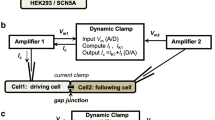Abstract
In previously reported work, we developed a new technique, synchronization modulation, to electrically activate Na/K pump molecules. The fundamental mechanism involved in this technique is a dynamic entrainment procedure of the pump molecules, carried out in a stepwise pattern. The entrainment procedure consists of two steps: synchronization and modulation. We theoretically predicted that the pump functions can be activated exponentially as a function of the membrane potential. We have experimentally demonstrated synchronization of the Na/K pump molecules and acceleration of their pumping rates by many fold through use of voltage-clamp techniques, directly monitoring the pump currents. We further applied this technique to intact skeletal muscle fibers from amphibians and found significant effects on the membrane resting potential. Here, we extend our study to intact mammalian cardiomyocytes. We employed a noninvasive confocal microscopic fluorescent imaging technique to monitor electric field–induced changes in ionic concentration gradient and membrane resting potential. Our results further confirm that the well-designed synchronization modulation electric field can effectively accelerate the Na/K pumping rate, increasing the ionic concentration gradient across the cell membrane and hyperpolarizing the membrane resting potential.







Similar content being viewed by others
References
Apell HJ (2003) Toward an understanding of ion transport through the Na, K-ATPase. Ann N Y Acad Sci 986:133
Astumian RD (1997) Thermodynamics and kinetics of a brownian motor. Science 276:917
Astumian RD (2003) Adiabatic pumping mechanism for ion motive ATPases. Phys Rev Lett 91:118–124
Bertorello AM, Ridge KM, Chibalin AV, Katz AI, Sznajder JI (1999) Isoproterenol increases Na/K ATPase activity by membrane insertion of α-subunits in lung alveolar cells. Am J Physiol 276:L20–L27
Blank M, Soo L (1989) The effects of alternating current on Na,K ATPase function. Bioelectrochem Bioenerg 22:313–322
Blank M, Soo L (1996) The threshold for Na,K-ATPase stimulation by electromagnetic field. Bioelectrochem Bioenerg 40:63–65
Blank M, Soo L (2001) Optimal frequencies in magnetic field acceleration of cytochromic oxidase and Na/K-ATPase reaction. Bioelectrochemistry 53:171–174
Blank M, Soo L (2005) A proposed explanation for effects of electric and magnetic fields on the Na,K-ATPase in terms of interaction with electron. Bioelectromagnetics 26:591–597
Buchanan R, Nielsen OB, Clausen T (2002) Excitation- and β2-agonist-induced activation of the Na/K pump in rat soleus muscle. J Physiol (Lond) 545:229–240
Chen W, Wu WH (2002) The asymmetric, rectifier-like I-V curve of the Na/K pump transient currents in frog skeletal muscle fibers. Bioelectrochemistry 56:199–203
Chen W (2006) Voltage-dependence of carrier-mediated ion transporters. Phys Rev E 73(Pt 1):021902-1-7
Chen W, Zhang ZS (2006) Synchronization of the Na/K pump by a train of pulses. J Bioenerget Biomembr 38:319–325
Chen W, Zhang ZS, Huang R (2007) Entrainment of Na/K pumps by a synchronization modulation electric field. J Bioenerget Biomembr 39:331–339
Chen W, Dando R (2007) Synchronization modulation of Na/K pump molecules can hyperpolarize the membrane resting potential in intact fibers. J Bioenerget Biomembr 39:117–126
Chen W, Dando R (2006) Electrical activation of Na/K pumps can increase ionic concentration gradient and membrane resting potential. J Membr Biol 214:147–155
Clausen T (1998) Clinical and therapeutic significance of the Na,K pump. Clin Sci 95:3–17
Clausen T (2003) Na/K pump regulation and skeletal muscle contractility. Physiol Rev 83:1269–1324
Clausen T, Nielsen OB (1998) Rapid activation of the Na/K pump: mechanisms and functional significance. Bio Skr Dan Vid Selsk 49:153–158
De Weer P, Gadsby DC, Rakowski RF (1988) Voltage dependence of the Na-K pump. Annu Rev Physiol 50:225–241
Gross D, Loew LM (1989) Fluorescent indicators of membrane potential: microfluorometry and imaging. Methods Cell Biol 30:193–218
Kaminski PM, Wolin MS (1994) Hypoxia increases superoxide anion production from bovine coronary microvessels, but not cardiac myocytes, via increased xanthine oxides. Microcirculation 4:231–236
Loew LM (1993) Confocal microscopy of potentiometric fluorescent dyes. Methods Cell Biol 38:195–209
Markin VS, Liu DS, Rosenberg MD, Tsong TY (1992) Resonance transduction of low level periodic signals by an enzyme: an oscillatory activation barrier model. Biophys J 61:1045–1049
Nakao M, Gadsby DC (1989) [Na] and [K] dependence of the Na/K pump current-voltage relationship in guinea pig ventricular myocytes. J Gen Physiol 94:539–565
Pedemonte CH (1988) Kinetic mechanism of inhibition of the Na-pump and some of its partial reactions by external Na(Nao). J Theor Biol 134:165–182
Pesce L, Carmen G, Comellas A, Ridge KM (2000) Beta-agonists regulate Na,K-ATPases via novel MARK/ERK and rapamycin-sensitive pathways. FEBS Lett 486:310–314
Rakowski RF, Gadsby DC, DeWeer P (1997) Voltage dependence of the Na/K pump. J Membr Biol 155:105–122
Rose AM, Valdes R Jr (1994) Understanding the sodium pump and its relevance to disease. Clin Chem 40:1674–1685
Sims PJ, Waggoner AS, Wang CH, Hoffman JF (1974) Studies on the mechanism by which cyanine dye measure membrane potential in red flood cells and phosphatidylcholine vesicles. Biochemistry 13:3315–3330
Teissie J, Tsong TY (1980) Evidence of voltage-induced channel opening in Na/K ATPase of human erythrocyte membrane. J Membr Biol 55:133–140
Tsien RY, Ernse LA, Waggoner AS (1990) Fluorophores for confocal microscopy: photophysics and photochemistry. In: Pawley J (ed) Handbook of confocal microscopy, Plenum Press, New York, pp 169–178
Tsong TY (2002) Na,K-ATPase as a brownian motor: electric field-induceconformational fluctuation leads to uphill pumping of cation in the absence of ATP. J Biol Physics 2:309–325
Waggoner AS (1979) Dye indicators of membrane potential. Annu Rev Biophys Bioeng 8:847–868
Acknowledgement
This study was partially supported by research grants from the National Institutes of Health (NIGB 2R01 50785 and NSF PHY0515787).
Author information
Authors and Affiliations
Corresponding author
Rights and permissions
About this article
Cite this article
Chen, W., Dando, R. Membrane Potential Hyperpolarization in Mammalian Cardiac Cells by Synchronization Modulation of Na/K Pumps. J Membrane Biol 221, 165–173 (2008). https://doi.org/10.1007/s00232-008-9094-8
Received:
Accepted:
Published:
Issue Date:
DOI: https://doi.org/10.1007/s00232-008-9094-8




